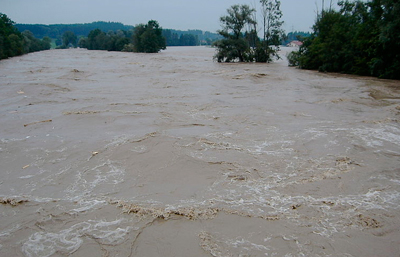Case study description
Cities involved: Ulm in the federal state of Baden-Württemberg and Neu-Ulm in Bavaria
Affected Population: 6033 inhabitants
Last flooding episodes: 1999, 2002
The cities of Ulm and Neu-Ulm are neighbouring cities at both sides of the Iller river, which draws the administrative border between the most southern German federal states of Baden-Württemberg and Bavaria. Both cities are also located down-stream, as the Iller discharges into the Danube in Neu-Ulm close before Ulm. Therefore, they are mainly affected by flood risks of the Iller, which showed during the severe 1999 Whitsun flood, where up to one-third of the city centre in Neu-Ulm, as well as parts of the old city of Ulm were flooded. In 2002, Neu-Ulm was again affected by flooding, even though to a lesser degree and in June 2016, both cities were affected – but not strongly – by heavy precipitation rates. Triggered by the severe flood in 1999, both cities installed flood protection systems, which were concluded in Neu-Ulm in 2008 and in Ulm in 2006. The construction of extensive flood defence infrastructure in combination of the long time period since the last major flooding, have lead to a perception of safety regarding flood risks.

Capacity assessment
The severe 1999 flood seems almost forgotten by citizens and civil-society actors in both cities, which is particularly expressed through low flood risk awareness, low motivation to get engaged into flood risk mitigation and therefore missing respective networks. Moreover, local knowledge about past floods apparently does not exist among citizens. Motivation to get involved is further reduced due to high technical flood protection, leading to citizens and municipal actors feeling rather safe and not considering residual risk. According to official statements, flood defence infrastructure in Neu-Ulm is designed for HQ100 floods (floods with a probability of occurring once a 100 years), whereas in Ulm, it is designed for HQ 200. In addition, individual insurance for houses is very high in Ulm – within the whole federal state of Baden-Württemberg the insurance rate lies at 95%. There are forums for participation in flood risk management in Baden-Württemberg (so-called flood partnerships), which address representatives of municipalities, associations and insurance. Nonetheless, du to the perception of safety, they seem not to play an important role.
Pilot Actions
Selection
As knowledge on and motivation for flood risk mitigation are rather low, the strategy for the planning and implementation of regarding participatory mechanisms and pilot actions was since the beginning to link the topic to general sustainability issues and to the Iller river in general. For this reason, a stakeholder selection process identified representatives of important local groups connected to flood risk mitigation or sustainability in general. In two workshops in Neu-Ulm and Ulm, the capacity assessment as well as potential pilot actions were presented and discussed. Additionally, participants filled out a questionnaire on their individual perceptions. This questionnaire was also sent to those stakeholders, which could not attend the meetings. Congruent to the results of the capacity assessment, it became clear that the main emphasis has to be put on knowledge dissemination and generation.
Description
Main pilot action and coordinating tool for all additional actions is going to be a website on the rivers Iller and Danube – participants decided in the workshop that a sole focus on the Iller river is not viable, as most people in Ulm identify with the Danube. The website will aggregate information on the rivers, such as water levels or renaturation measures conducive to decreased flood risk for smaller floods. Moreover, it will announce activities and events. Apart from an excursion to the river site to present the aforementioned measures and general information on flood risk, these activities still have to be coordinated with local stakeholders.